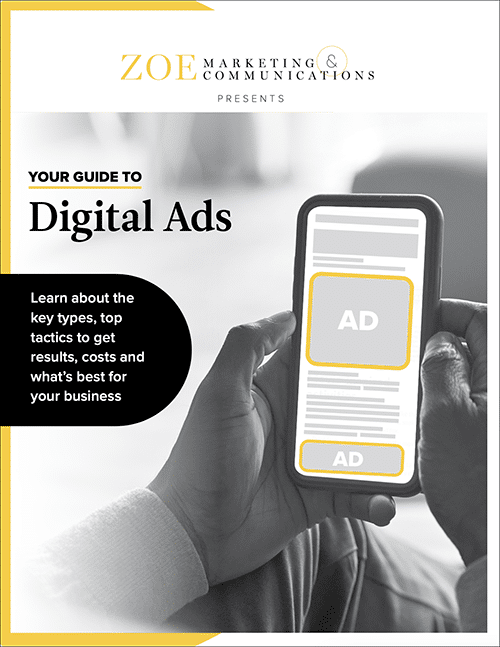
Download Your Digital Ads Guide
Learn how digital ads can help your business, including the tools, techniques and strategies to create successful campaigns.
Topics:
August 10th, 2023 | 2 min. read
By Kim Kovelle

Targeted digital ads, or programmatic ads, drive impressions, clicks and awareness with a highly aligned audience. And Zoe Marketing & Communications is ready to make your campaign a reality.
If you’ve signed on with Zoe, we know you’re eager to launch your programmatic ads. We’re here to make that process as smooth as possible.
This blog outlines our six-step onboarding process — so you’ll know exactly what to expect and how we set you up for success.
Learn how digital ads can help your business, including the tools, techniques and strategies to create successful campaigns.
You’ll have 2-3 key contacts in this process, and you’ll receive their emails. Feel free to reach out anytime.

Your audience targeting matters. We focus on people most likely to use your service or visit your business.

We require six standard sizes:
Keep it short and punchy — three lines max. We’ll help craft:
Provide your logo. Our team will help create impactful visuals to match your landing page.
Ads need refreshing every 30-45 days. Too much repetition leads to ad fatigue. We’ll work with you on updates to keep engagement strong.
To track campaign performance, we need viewer access to your Google Analytics (GA4).
This lets us analyze:

Fast turnaround, depending on your needs:
Deadlines keep your campaign on track. If one is missed, we’ll adjust — but staying on schedule is key for momentum.

We need 30 days of data before making adjustments. What to expect:
We monitor your results. If results are low, we tweak elements like colors, copy or targeting to improve performance.
The onboarding process is designed to be straightforward and stress-free. If you have any questions, our team is here to help.
Not a Zoe client yet? Talk to us about how targeted ads can work for your business.
If you’re already using programmatic, check out these next steps:

Learn how digital ads can help your business, including the tools, techniques and strategies to create successful campaigns.
As Zoe Marketing & Communications’ content manager, Kim Kovelle brings over 20 years of writing and editing experience in metro Detroit. She has strong roots in community journalism and a knack for making complicated topics make more sense.
Topics:
